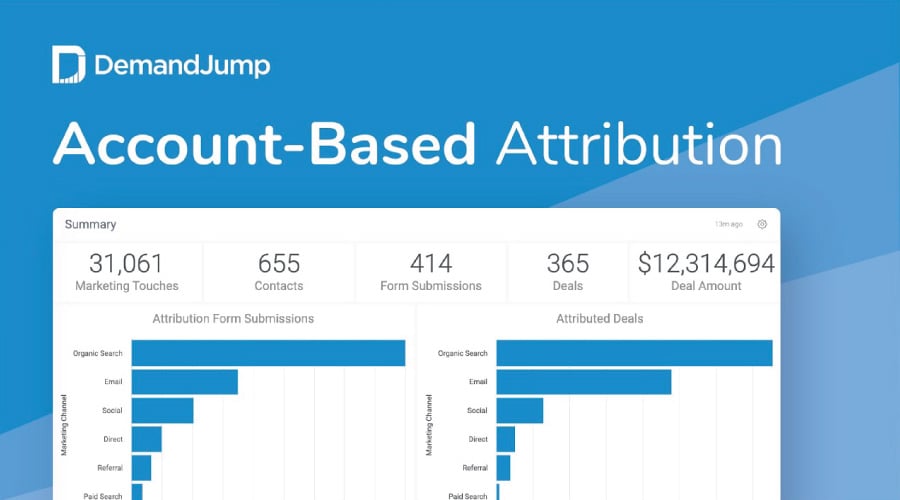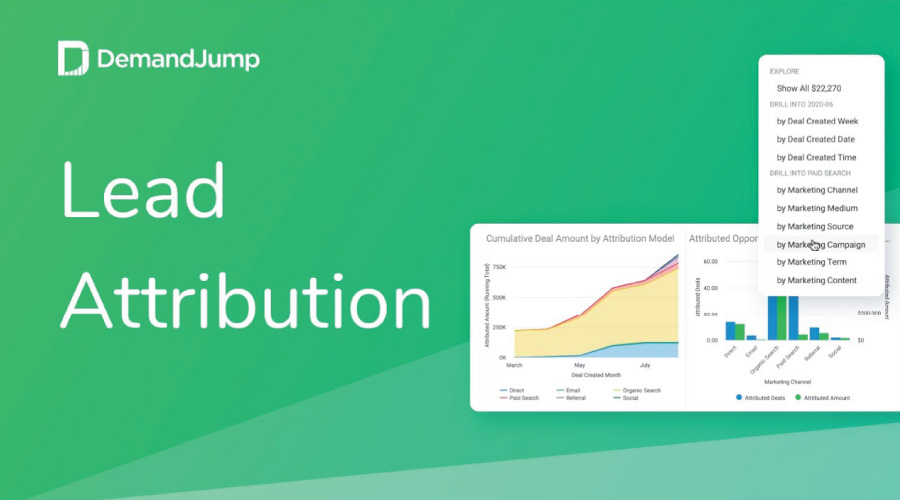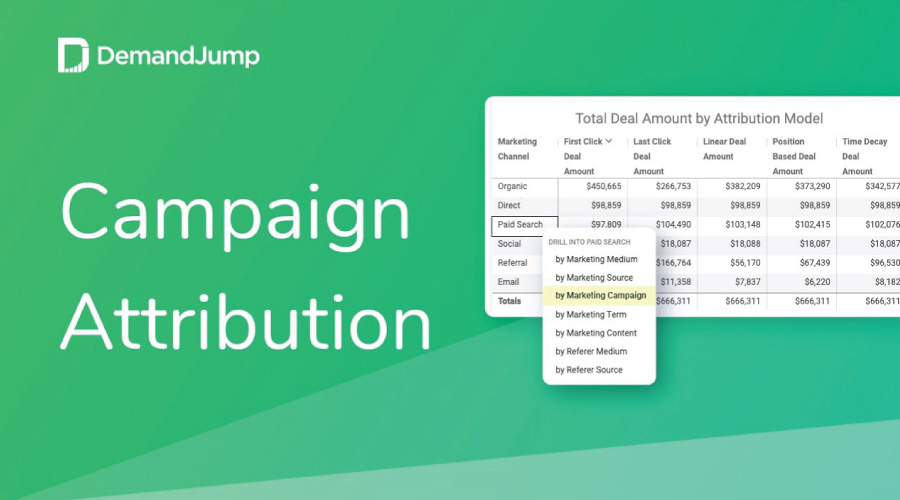Marketing Attribution
By embracing DemandJumps approach to SEO, we have been able to increase our organic rankings within just 2 weeks of implementing recommendations. This helped us see a 22% increase in organic search month-over-month.
Robert Jacko Vice President Digital Marketing @ Homage
DemandJump has become a crucial extension of our marketing team, providing game changing insights to fuel and propel all aspects of our digital marketing efforts. The DemandJump platform is a must have, we are seriously impressed.
Tim Lavinder Director of Ecommerce @ Hotsox
We used to spend hours looking for insights in dozens of tools and reports. Now we log into one place to find out what customers are doing and how to meet them where it matters most.
Zach Roop Digital Marketing Manager @ Dometic
We use DemandJump recommendations as our digital to-do list. We love going in and seeing the recommendations and knowing what to do next.
JoLynda Wilson Marketing Director @ IWC
Our Customers Love Attribution






Account-Based Attribution
Eliminate wasted time and spend. With DemandJump's automated account-based attribution
solution you will know with certainty which efforts are driving ROI.
Measure Your Marketing Performance
Find out which of your marketing efforts are making the biggest impact. See which channel drove consumers to you, the pages they visited, and all touchpoints along their path to purchase.
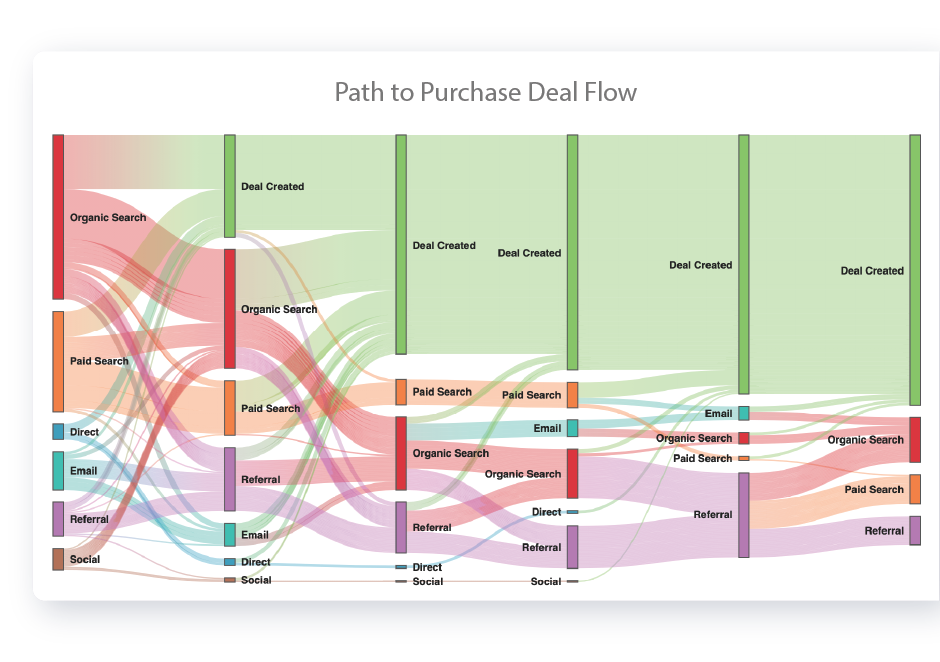
From Marketing Spend to Actual Pipeline Value
When a lead becomes a customer, you need to know which marketing channel or campaign should receive credit, and account-based attribution will give you the answers.
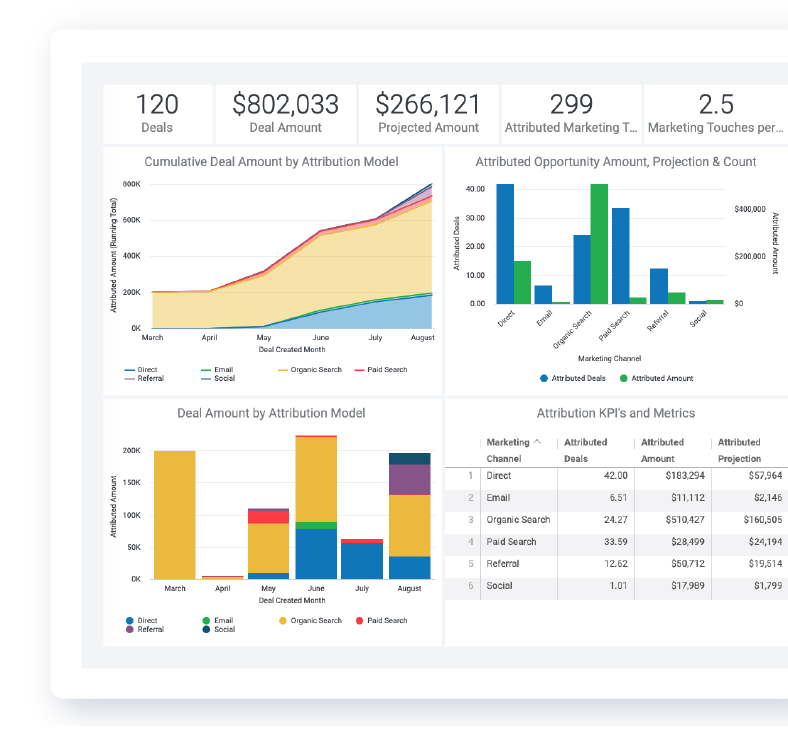
Organic & Paid Search Keyword Attribution
Beyond channel, campaign, and content attribution, you will finally see which organic and paid keywords are generating deal and opportunity revenue.
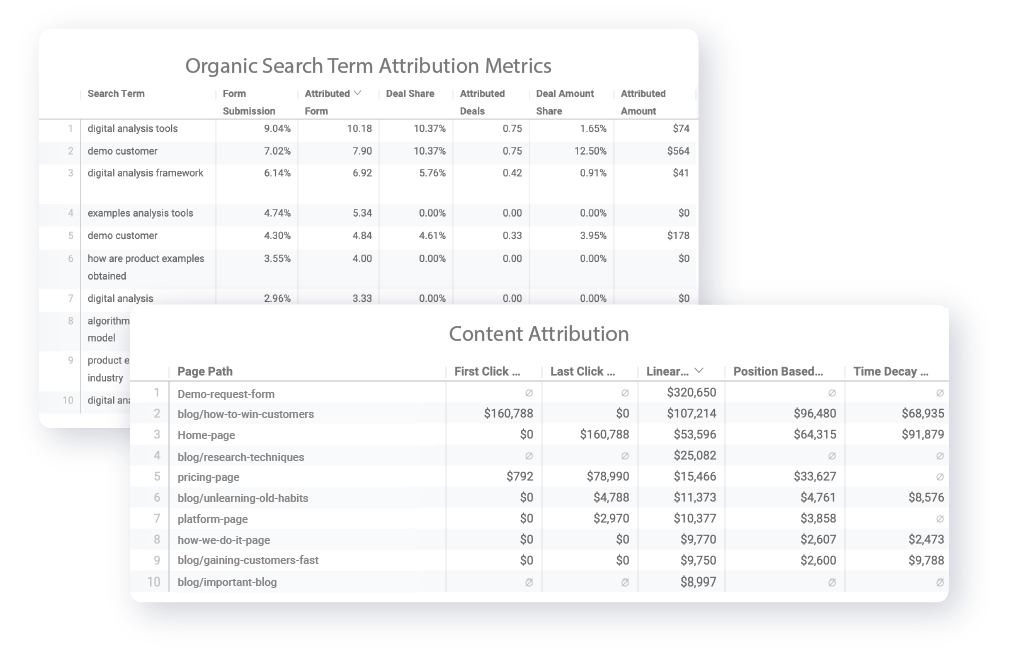
See a Demo of Attribution
Multi-Touch Attribution
Some great marketers are claiming that multi touch attribution is dead, but that's not exactly their intention. Multi touch attribution is a very relevant way to assess your analytics. What needs to be re-thought is the way that you use that information. There are definite weaknesses in relying solely on the information you can glean simply from your attribution tracking. You won't be able to figure in all of the other touchpoints where your audience had some contact with your brand, like print ads or word of mouth. That doesn't necessarily make multi touch attribution useless, it just means that in some cases a different attribution model may be the best solution.
Let's start by first discussing what multi touch attribution is and how it might have been used poorly. Multi touch attribution, sometimes shortened to MTA, is the process of tracking all of the different touchpoints a customer has on their path to purchase. This discipline attempts to track each individual across every device and channel. The intent is to form a complete picture of your audience and how to reach them, wherever they make contact with your brand. Sounds like a solid idea.
On the downside, many consumers don't like the idea of being tracked. It rings very Orwellian in nature. For brands, it means that you can more accurately position what the customer wants in front of them. But for the consumer, when done poorly, it can seem extremely intrusive.
An additional downside to MTA is that the original intention was to give a clear concept of the visitor's path to purchase. This helped inform the way marketers built sales funnels and mapped out the buyer's journey. It can still be used this way but marketers have to understand that they are getting limited data. They won't see all of the contact points that a customer makes in most cases. What can be seen in the analytics is data that can assist in forming a more complete picture of a company's customer persona.
What Is Attribution Tracking?
An attribution model is a way that you set up your analytics framework to gather data about your customers from set touchpoints. When you set up your attribution model, you're trying to see the different marketing channels a customer touches on their path to purchase. This information is helpful in showing you where to put more marketing effort for higher conversion rates. Attribution tracking can help you determine which channels your key demographics are responding to and allows you to use your marketing resources more effectively, resulting in higher ROI.
There are several types of attribution models that you can choose from.
- First Click Attribution: This attribution model attributes a conversion to their first touchpoint with a marketing channel.
- Last Click Attribution: This model measures the last click or last contact your customer has with your brand before conversion.
- Linear Attribution Model: The linear model seeks to measure all of the interactions with your brand and distribute attribution evenly across all touchpoints.
- Position Based Attribution: This model takes the first interaction and last interaction before conversion and gives both contact points credit.
- Time Decay Attribution: Time decay accounts for all of the interactions but it also accounts for the time lapse, or attribution window, in between actions and the resulting conversion.
- Last Non-Direct Click: This model removes any direct searches by the customer that leads them to your website or purchase area. So it only accounts for the contact points that are part of a campaign.
All of these offer a data driven attribution model and each will give you certain insights. For most brands, the best way to move forward is by utilizing multiple attribution models.
The reality is that none of these models will tell you everything you need to know about every customer in your sales funnel. They can each give you some general and some very good insights when used correctly. What we know for certain is that most customers have more than one contact with a brand before buying. While it's not yet possible to measure every single interaction, measuring the ones we can find will inform the way that we form our messaging.
If your data driven attribution model gives you insights that clearly show one of your channels under performing in conversion, it might lead you to abandon that channel or, more likely, adjust budget allocated to that channel. However, if you look at more data from multiple attribution models, you might find that a given channel is indirectly impacting conversions. It may not be the primary conversion point but it might function as a significant touchpoint along the path to purchase.
Most of your customers will want to build trust with your brand before purchasing. The points of contact don't only serve for conversion. They should also serve to strengthen that relationship. So removing a point of contact that serves in loyalty-building or name recognition could ultimately diminish conversion rates of bottom-of-the-funnel touchpoints.
Explaining Marketing Channel Attribution
Marketing channel attribution is a way that marketers measure the performance and assign credit to different channels. Each channel serves a different function and marketing attribution helps to determine which drives conversions. Some channels may primarily be geared to serve as a top of funnel touchpoint. Other channels may be the last contact before conversion. While there should be options in every touchpoint for your audience to convert to sales, overwhelmingly audience members will need more than one interaction before they make a purchasing choice.
This is not always the case. Some lower priced items may need much less in the way of convincing. Customers will often part with a few dollars in order to test out a product. But overall, many of your customers will see your brand or product several times before they decide to purchase.
When you use multi channel attribution methods, you develop a set of values for each action the customer takes. In simple terms, you might give credit to one campaign or channel for the ultimate conversion. The more attribution models you use, the more insight there is to gain.
A great deal of data can be difficult to measure. Using only one attribution model can lead to decision making that is not fully informed. For instance, if you're using a last touch attribution model, you will get a good idea of which channels are great at converting but you will not get the whole picture of your buyer's journey. The more completely you can gain insight into your customer’s path to purchase, the better you understand the customer. The better you know the customer, the better you can market to them.
There are a few ways that this information can benefit your marketing campaigns. First, it helps you to form a better picture of the way that your target audience behaves. You can more clearly see where they interact with your brand and some of these places might be surprising. When you see that a customer has come to your website multiple times through direct click, or not through a link from any of your touchpoints, that might give you some information about the way that they found your business. If this contact directly correlates to offline advertising campaigns, you can gather better analytics about the ROI of those advertising initiatives which can be difficult to measure in most cases.
The wider you cast your attribution net, the better you can develop a full picture of the buyer's journey.
Media Mix Modeling
Media mix modeling is a way that your business can measure performance from both offline and digital initiatives. We talked a bit about multi channel attribution and why it's important to use various models. Media mix modeling pays attention to all of the channel attribution available online and offline. The core reasoning behind developing a media mix model is that most of your customers will take different paths to conversion. Real world contact points are also important in the way that your brand builds relationships with new customers and it's exceptionally important in customer retention.
Customer retention is equally as important as new customer acquisition. Marketing is a mix of building relationships with new people and fostering current customer relationships. This means that your target audience will build an expectation of how they are communicated with among all channels and it's important to be able to see just where they find you, the duration of time they invest in each contact point, and where they tend to go before and after purchases.
This form of modeling doesn't just use internal data. Often the data you're using to gain insights includes internal data, trends, and external data from third party sources. This helps you to gain insights on your current customers, as well as your key demographic. A data driven marketing model looks more toward internal trends and analytics, where the media mixed model tends to bring in the whole picture to look for deeper insights.
What Is Multi Touch Attribution?
Multi touch attribution is often a phrase used interchangeably with multi channel attribution. They are slightly different though they are often used in connection with one another.
Multi channel attribution is really designed to assign credit to a conversion. It weighs the importance of a channel based on where it lands in the customer journey. It doesn't look at more specific information about that channel, such as the messaging that you're using on that channel. It looks at the regularity of touchpoints between your audience and that channel and when your customer interacted with that channel. For instance, some forms of multi channel attribution would give credit to the last touch point, where other models would give credit to the first touch point. This is a way to rate the importance of the channel in regard to conversion.
Multi touch attribution is a more unified way to analyze the data involved in your customer's journey. It looks at specific information, such as the ad, messaging, and design of the touch point on your customer's journey. The more detailed the data set, the more likely you are to arrive at actionable insights to inform better campaigns and messaging.
Multi touch attribution does offer a better way to gather precise data and develop insights, but it also has some of the same flaws that plague other tracking methods -- It's difficult to gather offline insights. You won't necessarily know how a customer came to your website or storefront when their first touchpoint was an offline channel. For example, if a radio or tv ad drove the customer to your brand that channel would not get credit. The customer might here a radio ad multiple times a day on their commute to and from work and one day decide to go online and search for the product or brand. That customer would appear to have found your brand solely via organic search. This is the downside of an attribution model that does not include offline channels.
Savvy marketers are developing ways to gain insight into a customer's offline touchpoints. For instance, you might include a hashtag or customer code for some small savings. These codes can be uniquely designed for each offline touch point so that you can gather data on how well those ads worked in your customer's journey.
What Is a Last Touch Attribution Model?
The last click attribution model is probably the most widely used, though not necessarily the most insightful. Last touch assigns credit to the channel that a customer interacts with right before converting. In some cases, it can be very telling. If you use this model, you'll be able to see a pattern in how the majority of your customers arrive at your location before conversion.
However, like other models, last click does not give a comprehensive view of the consumer journey. It does not take into account the various channels the customer has touched prior to that last touchpoint and resulting conversion. There is also no way to tell how many times they have interacted with your brand or the length of time in between interactions. For some brands, there may be several years worth of interaction because the customer doesn't necessarily think to look for your product until they are ready to purchase something in that specific market.
Last click attribution provides a ton of value, but it is not the right lead attribution model for every use case. Lead attribution is where you give the credit for the sale. For instance, if you've spent a lot of energy and time developing your email marketing campaign, it's reassuring to see a high number of conversions that come directly from that campaign. You can safely give the lead attribution credit to that campaign when the customer came from a link in the email.
However, you may have customers on that email list who also converted through direct search to your website. It may be ideal to go back to your email list and see the open rate for those contacts. You'll find that some customers may be swayed by one campaign but contact you later through another channel. There may also be follow up marketing initiatives involved. For instance, the same customer opened several of the emails in the campaign but hadn't decided to purchase. Then they ran across social media posts about your products. Then they ran across PPC ads. Their final contact was through direct search. But all of the different touch points helped to reinforce their decision to purchase.
How to Choose the Attribution Model for Your Business
There are several attribution models and they all have some benefits and limitations. For most brands, the best method to move forward with confidence is to choose several attribution models that give you the fullest picture possible. Ideally, you're looking for insights on your target audience that will help you create better messaging. This may include A/B testing and monitoring your analytics fully to be able to make changes as necessary for increased ROI.
Marketing Attribution Resources
Marketing AttributionAttribution Tracking
B2B Marketing Attribution
Hubspot Attribution
Marketing Campaign Influence
Mobile Attribution
Multi Touch Attribution
Offline Attribution
Sales Forecasting
Sales Opportunity Attribution
The Future of Data-Driven Marketing
Opportunities of Internet Marketing
Other Resources
Channel Optimization
Consumer Behavior
Consumer Insights
Consumer Insights and Analytics
Competitor Analysis Tools
Content Marketing
Content Strategy
Cross-Channel Analytics
Customer Insight Research Techniques
Customer Journey Map
Market Intelligence
Marketing Analytics Techniques
Market Research
Marketing Attribution
Opportunities of Internet Marketing
Types of Consumer Insights



